Hidden among the pines of rural southwest Georgia lies one of America’s most significant art environments, Pasaquan, a kaleidoscopic wonderland full of dizzying geometric patterns, vibrant mandalas, giant totems of serene faces and unusual buildings adorned with cosmic details. The seven-acre architectural gem is the life’s work of self-taught artist Eddie Owens Martin, whose handmade, psychedelic landscape was inspired by a series of visions. Located near the artist’s hometown in Marion County, approximately five miles from Buena Vista and three hours from Athens, Pasaquan is included on the National Register of Historic Places. The once-deteriorating site reopened last fall after an extensive conservation effort, making it a prime destination to add to your list of potential summer day trips.
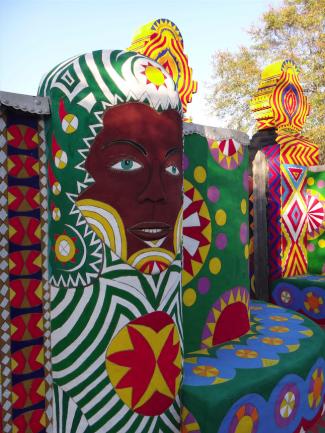
Photo Credit: Jessica Smith
Born in 1908—arguably decades too soon for the world to be ready for him—Martin led a life that some may consider to be the antithesis of the conservative community he was born into. At the age of 14, he left the Bible Belt and hitchhiked his way to New York City, where he became immersed in a Bohemian community of artists and picked up new roles as a drag queen, gambler, sex worker and tearoom fortune teller. His interest in astrology, psychic phenomena, world religions and ancient cultures grew, and he would frequently visit libraries and museums to research artwork and other fascinations.
Martin began experiencing visions in his mid-20s, with the first coming during a high fever. In these visions, he believed that members of a future race—the Pasaquoyans—were guiding him to change his name to St. EOM and begin building Pasaquan, a land where the past, present and future would co-exist. After inheriting a late-19th Century farmhouse from his mother in the mid-’50s, he returned to Georgia and spent the next 30 years dedicated to developing this new world.
Populated with boldly painted totems of Pasaquoyans, the compound consists of six major buildings that are connected by 900 feet of concrete walls, with nearly every inch embellished with otherworldly ornamentation. Walking through the pagodas offers a rare view into the life of St. EOM. The Mirror Room, named for a giant mirror that allowed him to keep an eye on the main entrance, is where he continued to offer the psychic readings that funded his artistic endeavors. The Oratory, a semi-circular room featuring a wall-length mural of muses dancing and playing drums, was a private space where he would meditate and play music.
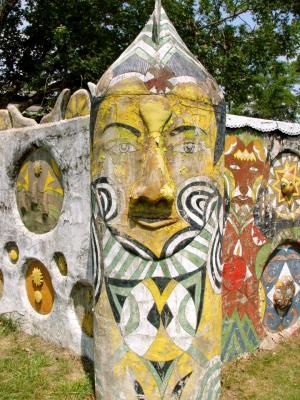
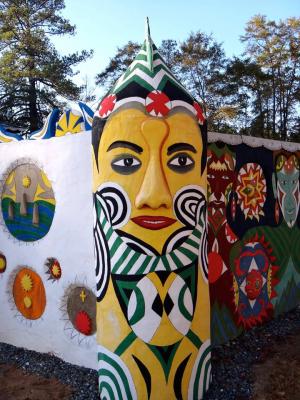
St. EOM envisioned a future where all cultures could live in harmony, and his work reflects this desire by interweaving stylistic influences pulled from African, Eastern, Native American and Mesoamerican art. Historical and spiritual symbols are interspersed among futuristic imagery, inviting visitors to contemplate their position in time and space.
Following St. EOM’s death in 1986, the art environment was bequeathed to the Marion County Historical Society, which soon formed the Pasaquan Preservation Society to care for the site and its sporadic visitations of day trippers. The elements slowly took their toll over time, deteriorating Pasaquan into a crumbling, sun-bleached ghost of its former glory, but the visible decline motivated the group to find new resources to ensure Pasaquan’s longevity.

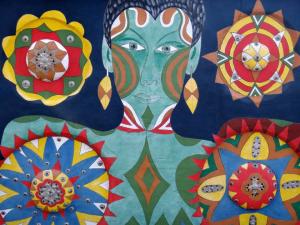
The PPS approached the Wisconsin-based Kohler Foundation, a nonprofit that has specialized in the preservation of art environments and vernacular architecture since the ’70s. Though the nonprofit initially declined when first approached in the late ’90s due to other projects at hand, a seed was planted that now, 30 years after St. EOM’s death, has blossomed into an enchanting, multimillion-dollar revival.
The Kohler Foundation launched a two-year restoration project in 2014—one of its largest and most complex undertakings to date—pulling in professional painting conservators from Parma Conservation in Chicago and objects conservators from International Artifacts in Houston and Los Angeles to work alongside additional technicians and craftspeople. The team worked diligently to stabilize the buildings’ structural integrity, adding new foundations and filling in cracks in the concrete as needed. Intricately patterned floors and hand-cut shingles of aluminum sheeting were reproduced, while the entire environment was given a fresh coat of paint to recreate St. EOM’s dazzling vision.
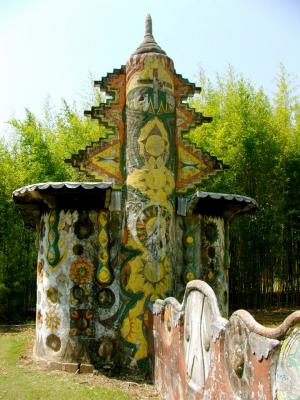

Over the course of his lifetime, St. EOM made over 2,000 works of art, ranging from paintings, watercolors, drawings, sculptures, ceremonial regalia and other adornments. The site’s climate conditions and limited space don’t allow for everything to remain, but many of these pieces can be found in “In the Land of Pasaquan: the Story of Eddie Owens Martin,” an exhibition currently on view at the LaGrange Art Museum through Saturday, Aug. 5.
Pasaquan officially reopened last October, and can be visited Friday–Sunday from 10 a.m.–5 p.m., with the exception of July and December. Stewardship is now overseen by Columbus State University, which intends to host performances, workshops and other education-based programs that embody St. EOM’s vision of uniting people of all cultures.
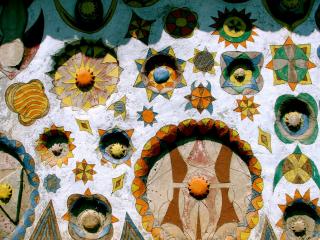
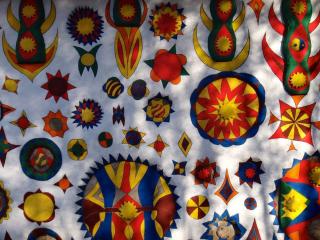
Pre-conservation photographs were taken in July 2012. Post-renovation images were taken in November 2016.
Like what you just read? Support Flagpole by making a donation today. Every dollar you give helps fund our ongoing mission to provide Athens with quality, independent journalism.










